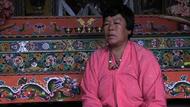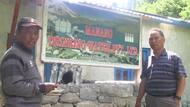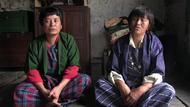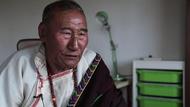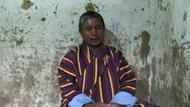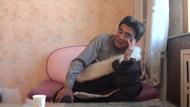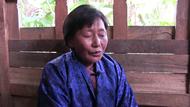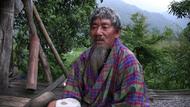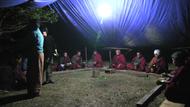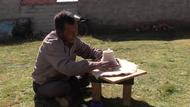Video Overview
Abstract:
Background: Few attempts have been made to evaluate the physiology of traditional Eastern health practices. The goal of this study was to evaluate the hemodynamic effects of the mysterious Buddhist practice of tumo. Tumo is a meditative practice that produces inner heat through the alleged cultivation of body energy-channels. Methods: This study was performed by members of an international expedition to the Himalayan Mountains in the Republic of India. The study was performed in an unpopulated outdoor mountainous area at an altitude of 16,400 ft with ambient temperatures between -10 and -15(°)C. Two (2) cohorts of subjects were studied: healthy non-yogi volunteers and tumo practitioners. All of the subjects were stripped down to their underclothes and exposed to the subzero atmospheric temperatures for 5 minutes. The volunteers were then passively rewarmed while the tumo practitioners performed tumo for up to 10 minutes. Blood pressure, heart rate, and stroke volume index (SVI) and cardiac index were measured noninvasively using a NICOM™ hemodynamic monitor, while carotid blood flow and biventricular performance were determined echocardiographically at each stage of the experiment. The total peripheral resistance index (TPRI), left ventricular ejection fraction (LVEF), and tricuspid annular plane systolic excursion (TAPSE) were determined using standard formula. Results: Fourteen (14) subjects (six volunteers and eight tumo practitioners) completed the study. There was one female subject in each group. With cold exposure, the SVI and carotid blood flow decreased while the TPRI increased significantly in both groups. In the volunteer group, these changes retuned to baseline with rewarming. Following tumo, the cardiac index (4.8±0.6 versus 4.0±0.5 l/m(2); p<0.01), carotid blood flow (445±127 versus 325±100 mL/min/m(2), p<0.01), LVEF (68±5 versus 64±7%; p<0.05) and TAPSE (2.9±0.4 versus 2.4±0.5 cm; p<0.01) were significantly higher when compared with baseline, while the TPRI was significantly lower (1786±189 versus 2173±281; p<0.01). Conclusions: Tumo was associated with a hyperdynamic vasodilated state with increased biventricular performance. We postulate that tumo results in a massive increase in sympathetic activity with activation of brown adipose tissue and marked heat production. The increased heat production may explain the paradoxical vasodilatation in tumo practitioners exposed to subzero temperatures.
Speaker Bio: Alexander Levitov
Alexander B. Levitov MD, FCCM, FCCP, RDCS is a professor in the division of Pulmonary & Critical Care Medicine and Director of the Ultrasound Training Program at Eastern Virginia Medical School. He is board certified in Internal Medicine and Critical Care Medicine and a Registered Diagnostic Cardiac Sonographer. Dr. Levitov is a nationally and internationally recognized expert in bedside ultrasound. He received the Presidential Citation for Outstanding Contributions from the Society of Critical Care Medicine. Dr. Levitov is a visiting professor at Harvard Medical School, Goethe University in Frankfurt, Germany and Yangzhou University in China. He directs several Certified Medical Education ultrasound courses in the United States and internationally. His invitational lectures are too numerous to count. He is a known and respected teacher and is a member of the University of Virginia Academy of distinguished educators since 2006. Dr. Levitov serves on the SCCM’s Critical Care Ultrasound Guidelines Task Force, the ACCP’s Taskforce on Critical Care Ultrasonography, and he is a member of the ACC/AHA’s Non-invasive Evaluation Appropriateness Task Force. Dr. Levitov holds several patents related to medical innovation including ultrasonography.
- So, hi ladies and gentlemen, my name is Alex Levertov. I am a professor of medicine in East Virginia Medical School, and have been a participant of 2012 Expedition to study G-Tummo. And was an advisory position with 2018 expedition for the same purpose. I will try to summarize the information that has been discovered during those expeditions.
- I work as a clinical professor of medicine, basically a doctor, for the most part, I was offered to study Tummo and was under full assumption that this practice is a hoax. Until I came and did some of the studies. My interest in medicine is ultrasonography. And a lot of the data that will be here presented will be presented. In terms of clinical ultrasound.
- I have no disclosures. Unfortunately, there have been no attempts to corrupt me over lately. There’s a nice little picture by the Russian painter Nicolas Rarick in 1932, depicting the practice of Tummo that we will talk about in a moment.
- So what is Tummo, the meaning is inner fire or she fire. It’s an ancient Buddhist practice. And practitioners of that demonstrate incredible tolerance to low in ambient temperature, without ill effects that will occur in every person who will be exposed to that amount of time to that temperature. That is to say there is no hypothermia. That would be a lethal complication of cold exposure or frostbites is everything that came to the Tibetan plate plateau. It came from the plains of India and it’s somewhat based on the Hindu practice of Agni Sara. Though different from it, but being a physician, I would not further comment.
- As a nice gentleman there, attempting to get himself exposed to the ice in Himalayas. Obviously not well dressed for them. So the aim of the first expedition was to evaluate hemodynamic response to high altitude and cause exposure and to compare healthy volunteers to Tumo practitioners. When I talk about healthy volunteers, they were really healthy and one of the gentleman had two trips to Everest. So they were basically more of elite athletes than what you would associate with a normal volunteer.
- So there would be attempts to understand hemodynamics have Tumo practice or what’s happening to the vessels of both volunteers and the practitioners when they are exposed to the cold and therefore, to discover how the practice prevents people from cold related injuries.
- Our equipment was solid state ultrasound equipment that was suited for high altitude it was furnished by Sonosite company. That was the only commercial participation there. We also have a Cheetah Nikon Bioreactance system, which discovers vasculature condition by checking by reactions, that is to say, the resistance of, of the body to electricity, which is largely dependent on on the movements of blood.
- There’s two American physicians, one Israeli physicians, and one PhD in physiology that were participate. So, the data collection at 18,000 feet, there were eight practitioners of Tumo and five healthy volunteers, they were exposed to cold and then the data was collected with passive rewarming to comfort and volunteers and rewarming by Tumo practice with exercise and visualization by the practitioners in subsequent data collection.
- So, as far as bioreactants, we can see that a number of measurements was considerable. And what we were trying to see is overall condition of vasculature with cold exposure and without. One of the descriptors of that would be a so called peripheral resistance.
- That is to say, in simple terms, that that will be what will be described: whether the vessels are dilated, or the vessels are constricted. You can see in volunteers, with with passive rewarming, the peripheral resistance was without significant change about 2000, during cold exposure, and during passive rewarming. As far as Tumo practitioners, however, the difference was quite interesting. One would expect that peripheral resistance will go up that as the vessels will constrict during cold exposure, and will continue to do so as long as it as long as the person is exposed to cold.
- However, we’ll see fairly profound vasodilatory effect of a Tummo practice. That is to say, instead of vessels constricting, they dilate to a significant degree in the p value with relatively small amount of observation was 0.01. So that was that difference was statistically significant.
- So what we demonstrated that, though not statistically significant, the cardiac output was higher in two more practitioners, as opposed to elite athletes that served as healthy volunteers. And that peripheral resistance was significantly decreased compared to normal rewarming in the Tummo practitioners showing that somehow, in counter intuitively, there was a significant dilatation of all vessels is to those who practice to move for warmth, compared to normal volunteers.
- After that, we’re attempted to take a look at specific vasculature and this is a result of carotid flow analysis. carotid flow, of course, goes to the brain. And interestingly enough, almost never changes under any circumstances, even headstands, and other practices that seemingly would increase cerebral blood flow, the blood flow to the brain actually do the opposite. It’s a glial mechanism and it’s a demand driven mechanism and therefore, it tends to be very stable and not affected by much of anything.
- But we could see, interestingly now, that at cold exposure, the Tumo practitioner will have a blood flow of 700 millimeters per minute to the brain, but during the practice rewarming when visualization and exercises are involved, it nearly doubles, which would be a result that was quite astonishing.
- So looking at distribution of people, male and female, there’s only one female and multiple males that had the practice of cold exposure carotid blood flow, blood flow to the brain 300 cc’s during Tumo 500 cc’s, little less, here nearly tripled, doubled, nearly tripled up up up in all the p value of 0.05, which is statistically significant and remarkable to see in such a small sample.
- So, Tumo practitioners definitely increase cerebral blood flow flow good blood flow to the brain, there might be an increase the diastolic component which makes it even more so because in diastole, blood usually doesn’t go to peripheral organs, but goes to the brain and kidneys only, it is very likely demand driven that is there is an increase in brain activity and increased metabolic demands, which supported somewhat by independent functional MRI data.
- Echocardiographically, looking at what the heart is doing during the practice, we could see that median increase in inferior vena cava, which is the vein that carries all the blood to the heart, from organs below the diaphragm also is dilated, which means that not only there is an increase of blood flow to the brain, but also increase blood flow to the peripheral organs. And this is a picture of inferior vena cava, you’re going through the liver.
- And you can see the same thing happening there. There is appears to be some increase in the right ventricular function. And that’s easy to understand if the vessels are dilated peripheral vessels that would require right ventricle to process more blood as it returns to the right ventricle and needs to be sent to the left ventricle for and from there to the periphery. A picture of that happening for a picture that was obtained on the portable equipment the 1800 feet, 1800 feet, actually 18,000 feet, I’m sorry, of altitude. That seems to be a pretty good picture.
- And then just there there was not really much of a difference in stroke volume and ejection fraction that is amount of the blood that leaves the heart in healthy volunteers, but there was a significant increase in left ventricular function in Tumo practitioners. That is that the heart was working harder to support the increase of blood delivered to the periphery.
- Here’s a results summary with significant changes being in the red. There was no real significant changes in healthy volunteers of anything. In Tumo practitioners post their practice card again index went up on an average from three liters per minute to nearly five heart rate stayed exactly the same blood pressure stayed the same. Here’s a results summary with significant changes being in the red. There was no real significant changes in healthy volunteers of anything. In two more practitioners post their practice card again index went up on an average from three liters per minute to nearly five. Heart rate stayed exactly the same, blood pressure stayed the same.
- Peripheral resistance dropped from 2600 to 1700, which is a profound vasal dilator that's something that you would see with a heatstroke carotid for increase significantly on an average from 269 millimeters per minute per meter squared to 445. That is a remarkable increase of blood supply to the brain ejection fraction. And that describes right to left ventricular function and TAPSE, there is no reason to tell you what it is, but that describes right ventricular function, both went up.
- And this understandable but because it needs to support the above. So thoughts and directions of further research certainly, it appears, the practice of tumo breaks most of the things that we associate with a cold exposure, the cardinal cold exposure, vascular response and normal people is vasoconstriction. However, in people who practice Tumo, there appears to be profound vasodilation it’s obviously an effect that is somewhat difficult to understand because you cannot dilate your own vessels, if you could, obviously, people would never have high blood pressure.
- So there appears to be a controll of vasodilation in that practice that is somewhat unique. Probably neuro hormonal in nature, there’s maybe an increase in CNS oxygen demand increasing in carotid blood flow. There’s also interesting that most of human adaptation to cold occur with somewhat of a caloric restriction. And that’s very likely why people attempt to preserve heat, when quite opposite in Tumo vasodilation would require a dramatic increase in caloric expenses. In a practitioner, as opposed to as opposed to somebody who goes through normal adaptation to to exposure to cold, gently sitting on the ice here, attempting to practice.
- So there’s a little bit more that was done there, which is also somewhat interesting. In in 2018, I wasn’t there, like October of 2018, there was a study that attempted to correlate Tumo practice with condition of superior mesenteric artery, we were thinking that as long as the blood increases to the brain, their results, so perhaps further increase to blood flow to the splenic organ.
- And indeed, it appears to be the case to a considerable statistical significant after 100 probes that there, there is a increase in both systolic and diastolic flow to the to the to the mesentery to the guts. Again, it appears to be that odd autonomic functions are being controlled. It’s very difficult to state of what causes it, but I also would like to point out that there is it’s not really that unique as it appears, certainly with we eat a hot pepper, the ambient temperature doesn’t change any, but vasodilation is produced and you feel like you’re sweating.
- So, perhaps the mechanism is not dissimilar. That will fool the valvanomic system into believing that it is doing something that it’s supposed to do that just my little thought of how it’s possible obviously none of that has addressed the neural and hormonal mechanisms of how that how that vasodilation was achieved and this is the same Nicholas Roerich, the mountain of five treasures or which one is a wisdom and hopefully we will acquire a more wisdom as as well as study this practice further.
- And I will be more than happy to answer any questions if you have any.
- I will just ask a few questions. Just understand better the setting? Sure, who are your Tumo subjects?
- I will be happy to if somebody else will have questions and further I would be happy to answer them with personal emails. I, it was a mixed bag. They were some there was four Westerners and they were Eastern practitioners, whatever, I forgot the numbers all together sort of almost equal.
- I think there was one more Westerner, one of the Westerners spent about 20 Years in Tibet, that was the lady that female in the monastery, so she’s kind of in between, but that’s a composition of Tumo practitioners.
- Okay, thank you, you have not measured the temperature right what happened was a core body temperature?
- We have not looked at core body temperature, we vary as as the study states, The attempt was just to look at hemodynamics that is blood flow. And to see what what happening obviously the the vasodilation will cause increase in body temperature the splenic or core temperature, there is an increase in splenic superior mesenteric artery flow and that flow it’s 238 some degrees. So if there is an increase in flow, you cannot avoid but to increase core temperatures.
- So that’s that’s fairly obvious. There’s probably increase in brain temperature as well associated with a high flow. It would be impractical to check out I will be happy to if somebody else will have questions and further I would be happy to answer them with personal emails.
 Loading ...
Loading ... 